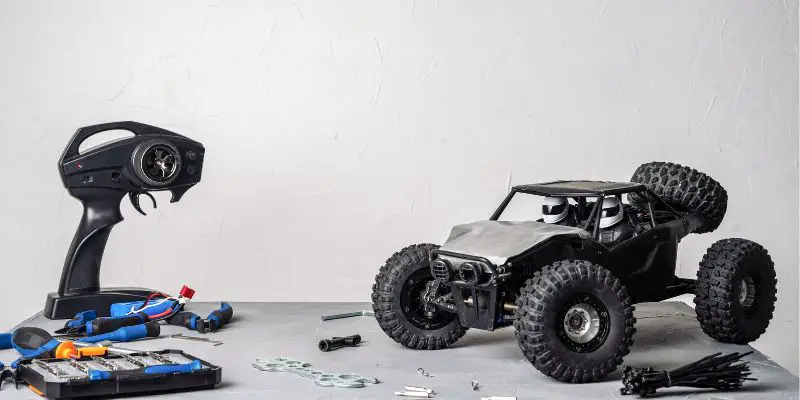How Do Remote Control Cars Work?
We would always advise people to buy a pre-built RC Car, but for those that are technically gifted you may be wondering, how do RC Cars work?
In this article, we will answer that question and show you what goes into an RC Car build. Also, if you are thinking of building your own we have included a list of parts and tools that you will require.
What Parts Are In An RC Car?
To understand how remote control cars work you first need to understand what parts make up a typical RC car. You may be surprised at just how complex the inside of your RC car is, not to mention how snug everything has to fit.
Chassis
The chassis is the main surface to that all of your RC parts are bolted. Often made from a durable, flexible plastic compound the chassis is arguably one of the most important parts of an RC car build.
Made to take impact from all angles and keep the inner components from getting damaged, the chassis needs to be able to withstand a lot.
The chassis is like a base plate that goes at the bottom of the RC car, it doesn’t necessarily have to be aesthetically pleasing although you can buy anodised metal ones that are made from alloy.
Wheels
Wheels and rims are responsible for transferring power from the chassis to the ground.
There are a variety of different types and sizes of wheels and rims available on the market, so it is important to choose the right ones for your specific vehicle.
For example, if you are looking for an off-road RC car, you will need a set of wheels and rims that can handle rough terrain. On the other hand, if you plan on driving your car on paved surfaces, you will need a set that is designed for smoother surfaces.
In addition to choosing the right type of wheel or rim, it is also essential to make sure that they are properly balanced. This will help ensure that your RC car drives smoothly and doesn’t vibrate excessively.
Make sure to keep checking your wheels for any damage as that can start to affect your RC car’s performance, even the smallest chip can change your RC car’s speed and handling.

Tires
So you have decided on what wheels or rims you are going to go with, well that’s great but you won’t be going very far without a set of tires.
Just like wheels, tires need to be picked depending on the activity that they are going to take. For example, if you are building a drift RC car then you should be aiming for a harder compound with plenty of grip. Alternatively, if you are going for a rock crawler setup then a more spongy, shock-absorbing wheel should be used.
RC car tires are made from synthetic rubber and can last for a long time providing they have been taken care of.
You might be interested in: Why do RC car tires balloon (and how to prevent it)
Suspension
Suspension or shock absorbers are usually made from a dampener with a coil around them. They are attached to the wheel and then attached to the chassis.
As the name suggests, they absorb the shock from the terrain. This stops any unnecessary damage being caused by the constant changes in the ground.
If you try to build an RC car with no suspension, you will find that your internal parts start to become loose and get damaged. You will also find it very hard to keep the car under control.
There are many types of suspension available, you should look for one that fulfils your RC car’s needs. Too spongy and you will affect the speed, too rigid and won’t be able to do any stunts. There are suspension sets for all types.
Gears/Cogs
Gear and cog sets are used to connect the motor of your RC car to the differential and in turn, connect the power to the wheels.
They are a vital piece of equipment and should be assembled correctly otherwise you could damage the “teeth” that interlock from one cog to the other.
The typical gear and cog set is made from synthetic plastic but if you are willing to pay a little more you can get metal ones made from alloy. The metal ones are less likely to break and have less chance of slipping.
Front & Rear Axle
The axle is what connects the wheels to the chassis, allowing each wheel to turn independently. Axles are made from metal and have to be able to rotate are great speeds.
Axles should be well greased internally and offer very little resistance. If an axle becomes dirty, corroded or damaged it can affect the speed and handling of your RC car.
Wheel axles should be maintained after you use your RC car, every time. Simply check them over for any damage and check for any debris that may have lodged itself in them.
Driveshaft
The driveshaft is what runs down the centre of the RC car and provides power to the axles. Whether the RC car is powered to the rear or front tires or 4×4 they will all need a driveshaft to run.
Driveshafts run at incredible speeds and also need to be properly maintained. Make sure to check it over every time you finish using your RC car.
A damaged driveshaft will cause your RC car to react in an unpredictable manner, causing it to lose power, stutter, lose the four-wheel drive or cause the whole RC car to shake.
Motor
RC car motors come in all shapes and sizes. The most common type of motor used is a brushed DC motor. They are cheap to produce and easy to maintain.
Brushed motors can be run at different voltages, depending on the power that you want to give them. The more volts you give them, the more power they will have.
There are also brushless motors available which are more expensive but offer more power and are easier to maintain.
You can also get nitro motors that run on 2-stroke gas. These are small cc engines that produce high torque and make for a loud experience!
Servos
To turn your RC car you will need servos. These little controllers move up and down and when connected to linkages different things can be achieved.
Servos are also used to open and close the throttle. You control the servos from your radio transmitter (controller).
Separate battery packs are used to power the servos, this needs to be remembered when planning out where you are going to mount the internals on the chassis.
ESC (Electronic Speed Controller)
The electronic speed control is a small electrical circuit used to regulate an electric motor’s speed and braking.
The ESC is the first thing you should check if your RC car is losing speed or failing to reach its top speed.
Without an ESC you won’t be able to get any drive from your motor’s power so make sure to keep it maintained and covered from moisture, debris and dust.
Transmitter
Finally, you will need to be able to control your RC car. This is done via a transmitter, commonly known as the controller.
The transmitter has to be paired with the car, you do this by using the same frequency band crystal that is provided with the receiver.
Frequency crystals are interchangeable and are simply plug-and-play. If you have the wrong crystal installed you will not be able to control your RC car. And, in fact, might control someone else’s.
What Tools Do I Need To Assemble An RC Car?
When building your own RC car you should make sure you have at least the very basic tools to complete the job.

Here is a list of tools that you will require, we have added some extras that aren’t necessary but will definitely come in handy:
- – Pliers
- – Screwdriver
- – Knife
- – Hammer
- – Wire cutters
- – Glue
Optional but recommended items:
- – Work stand
- – Threadlocker
- – Paint and paint supplies
- – Decals
What Motor Should I Choose?
When choosing a motor for your RC car you need to take into account what it is you are going to be doing and what type of budget you have.
Brushless Motor
This type of motor is the less common motor when it comes to electric-powered RC cars. They tend to be expensive but are very versatile and very efficient.
Because the motor uses magnets to produce power, it creates very little kinetic energy. This helps to stop the motor from burning out.
They come in different shapes and sizes and can be bought as part of a kit where you get an ESC with it. Make sure to check that the motor is the correct size for your scale of RC car before purchasing.
Brushed Motor
Brushed motors are a lot more common and this is because they are a lot cheaper than brushless ones. They are ideal motors for those who are trying to build an RC car on a budget.
Unfortunately, they do produce a lot of heat when running for long periods of time and tend to not have a long life cycle like their counterpart.
Like brushless motors, you can get them in lots of different sizes so make sure to order one that fits your scale.
How Do Wireless Remote Control Cars Work
The transmitter sends radio signals to a receiver unit installed in the car, which then translates those signals into movement.
The most common type of remote control car works on the 27 MHz or 49 MHz frequencies, which are regulated by the Federal Communications Commission (FCC). These frequencies are divided into different channels, with each channel having a specific purpose.
For example, Channel 1 is typically used for throttle or speed control, while Channel 2 is used for steering.
Some high-end remote-control cars also come with additional channels that can be used to control other functions, such as lights, winches, and so on.
In order for a remote control car to work, the transmitter must be within range of the receiver. The exact range will depend on the specific model of car, but most remote control cars have a range of between 30 and 100 feet.
Some remote-control cars also come with an antenna that can be used to extend the range.
Final Thoughts
So there you have it, we hope you now understand how remote control cars work and what goes on under the shell.
Remember there are kits out there that you can purchase if building your own car seems a little daunting, but if you relish a challenge then good on you!
I am a massive fan of anything that is remote controlled. This stems from my childhood when my Grandfather would take me to a local RC flying club and I would dream about having my own RC models someday.
